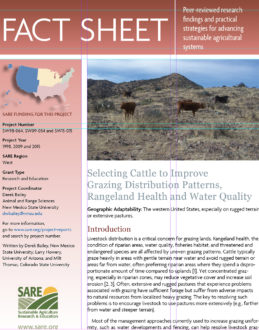
Geographic Adaptability: The western United States, especially on rugged terrain or extensive pastures.
Livestock distribution is a critical concern for grazing lands. Rangeland health, the condition of riparian areas, water quality, fisheries habitat, and threatened and endangered species are all affected by uneven grazing patterns. Cattle typically graze heavily in areas with gentle terrain near water and avoid rugged terrain or areas far from water, often preferring riparian areas where they spend a disproportionate amount of time compared to uplands [1]. Yet concentrated grazing, especially in riparian zones, may reduce vegetative cover and increase soil erosion [2, 3]. Often, extensive and rugged pastures that experience problems associated with grazing have sufficient forage but suffer from adverse impacts to natural resources from localized heavy grazing. The key to resolving such problems is to encourage livestock to use pastures more extensively (e.g., farther from water and steeper terrain).
Most of the management approaches currently used to increase grazing uniformity, such as water developments and fencing, can help resolve livestock grazing distribution problems on both private and public lands. However, these practices usually require large capital expenditures. As a result, ranchers and land managers are often reluctant to develop water and build new fences. Less expensive solutions, such as salting away from water, usually do not sustainably alter cattle grazing patterns [4, 5]. New management techniques are needed that reduce the reliance on large capital expenditures and that embed desirable transgenerational distribution patterns within and across cattle herds.
A series of three SARE-funded projects (SW98-064, SW09-054 and SW15-015) provide the only research that we are aware of that has evaluated whether grazing distribution has the potential to be improved through genetic selection. These studies showed that selection for distribution has great promise and that additional research is warranted. However, there is a great deal more to learn and many questions still must be answered. Below are a few ideas that resulted from this research that may be useful to ranchers grazing extensive or rugged rangeland.
Want more information? See the related SARE grants:
